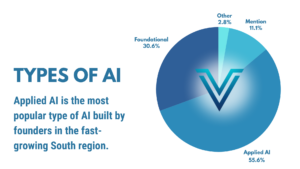Valor’s 2024 Q2 AI Startups in the South illuminates both the growth of AI Startups in the region as well as shifts in the landscape from Q1. To better understand the South in the context of AI Startups nationwide, here are the top two takeaways.
To no surprise, startups in the South across the board, namely the Valor investment pipeline, have been heavily engaging in AI. What sets Q2 apart from Q1, though, is the notable 20% increase in startups focused on foundational AI. Foundational AI describes the development of LLMs, algorithms, and novel AI systems as a whole, which indicates the high level of innovation and talent that resides in the South.
In comparison to the broader national landscape, startups investing in applications of AI are on the rise, but this steep increase in AI groundwork in the South opens the door for even more potential applications and startups. Therefore, as the investment pipeline has proven quarter by quarter, the South is home to untapped growth potential.
The second key takeaway deals with both the most prolific states in the south and the key AI-augmented sectors. From Q1 to Q2, the most productive southern states churning out AI Startups have introduced a fourth state to the mix. Specifically, during Q2, Florida maintained its lead as the most head-quartered state for AI seed and even pre-seed startups, followed by a tie between Texas and Georgia, with the list completed by Virginia.
Virginia’s entrance into the top three lends credence to the national trend of enterprise SaaS being the largest AI-augmented sector so far as cities such as Alexandria and Herndon are home to enterprise SaaS-focused startups. The South though, especially in Q2, has seen higher numbers of AI startups targeting the cybersecurity sector, stemming from key military installations within Virginia, Texas, and Florida as well as vast data centers. These data centers protect key information for large tech companies from Microsoft to Google, nurturing the demand for AI to streamline and protect sensitive information.
For the full report and graphs depicting these changes, click here.


